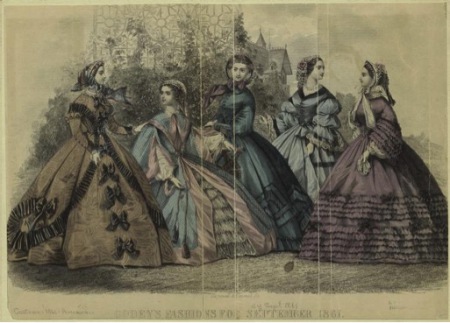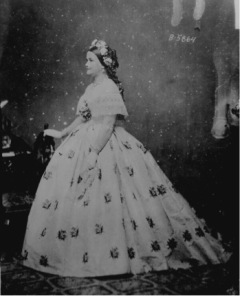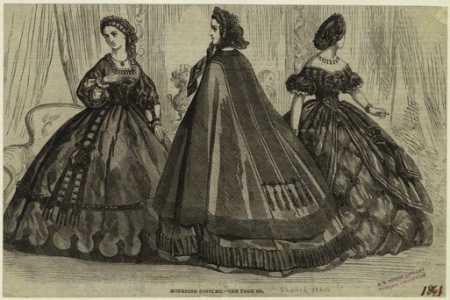Woman's Clothing
The Corset
Virtually every woman wore a corset of some type under their clothing, from working class women to domestic servants to genteel ladies of society. The ideal was a waist of 15 inches, but corsets did come in different sizes so we know that not everyone squeezed themselves to match this standard. Corsets were stiffened with whalebone, steel, or even oak splits for women in the South during the war.
Most corsets closed in the front with metal brads and eyelets, and more rarely they laced up the back with hooks and eyes. Women whose corsets laced up the back would have needed help dressing.
During the Victorian Age, including the Civil War, a tightly laced corset was widely associated with a woman’s virtue. In fact, many terms we use today to describe someone’s morality come from this association: “The allusion to loosening one’s stays [corsets] as a prelude to sexual activity permeated everyday life, so that women who were called “loose” were not being described physically so much as morally.
Here's where you can enter in text. Feel free to edit, move, delete or add a different page element.
The Hoop Skirt
The women’s fashion feature most associated with the Civil War era is the hoop skirt, named for the structural support of wire hoops or whalebones called “crinolines,” worn under the skirt to hold its shape. In a typical dress, the width of the skirt at its widest point (which was close to the floor) was about 50 to 70 percent of the woman’s height.
Many women saw the crinoline as an improvement over the weight and cumbersomeness of wearing multiple petticoats—and there was less laundry, but hoop skirts posed other challenges. Sometimes the skirts tilted up on one side, exposing views of legs and undergarments, and they could catch on fire if women stood too close to fireplaces.
Mourning Dress
Death touched the hundreds of thousands of families during the Civil War, and the women put on mourning attire according to their stage of grief.
The period of mourning varied according to the relationship with the deceased. A widow was expected to wear deep mourning for at least one year. This included dull, lusterless black fabric, widow’s cap, black cuffs and collars. Black petticoats, stockings and parasols were also required.
During the second stage of mourning (from twelve months to eighteen months after the death), the widow could trade off on fabric, such as silk or wool, and add jet black jewelry/ribbons to her attire.
The third stage of mourning commenced at eighteen months after the death, and allowed the half-mourning colors of grey, purple, mauve, lavender, or black and grey in her dress.
Layers of Women’s Clothing in the Civil War
Here's a list of the Civil War women’s clothing by layers:
Layer 1
* Drawers (underpants) made of cotton or linen and trimmed with lace
* Chemise (long undershirt) usually made of linen
* Stockings
Layer 2
* Corset or stays stiffened with whale bone
* Crinoline, hoop skirt, or 1 or 2 petticoats (dark color if traveling due to mud and dirt)
Layer 3
* Petticoat bodice, corset cover, or camisole
Layer 4
* Dress
* Belt
Layer 5 (outerwear for leaving the house)
* Shawl, jacket, or mantle
* Gloves or mitts
* Boots
* Parasol
* Bonnet or hat
* Bag or purse
* Handkerchief
* Fan sometimes made of sandalwood
* Watch pocket
Some Women's Accessories
Gloves Victorian modesty dictated that ladies should wear gloves when going out to church or to a dance. Gloves were not worn at all times and were removed when eating.
Fans Simple paddle fans made of palmetto leaves were round and small sized
Nosegay Small bunch of aromatic flowers and herbs was a popular accessory in an era without deodorant.
Small purses Drawstring bags held a lady's necessities.
Aprons often worn for cooking or doing chores protected dresses.
Lace was not widely used, except for collars and cuffs
Collar and cuffs were removable for laundering or a stylish change. These removable collars and cuffs were usually white.
Parasol - a fabric umbrella carried on a sunny day to protect a woman's complexion from the sun, and offered a kind of portable shade
References:
1. Women’s Fashion During the Civil War, Posted by Jocelyn Green on Apr 1, 2012 in Civil War history, Writing.
2. Stamper, Anita A. and Jill Condra. Clothing through American history: the Civil War through the Gilded Age, 1861-1899. Westport, CT: Greenwood, 2010. Page 109.
3. Leisch, Juanita. Who Wore What? Women’s Wear 1861-1865. Gettysburg, PA: Thomas Publications, 1995. Page 70.
4. Rutberg, B. Mary Lincoln’s Dressmaker. New York: Walker and Company, 1995. Pg 40.
Recommended Sutlers for women’s clothing:
Abraham’s Lady: www.abrahamslady.com
Originals by Kay: http://originals-by-kay.com
Civil War Lady: www.civilwarlady.com






